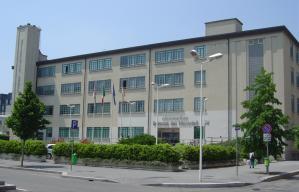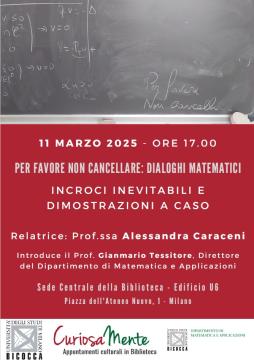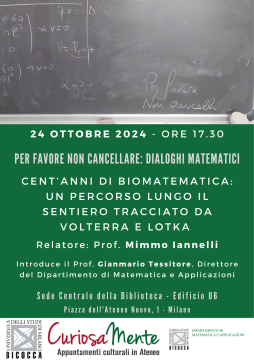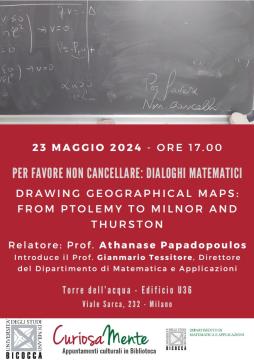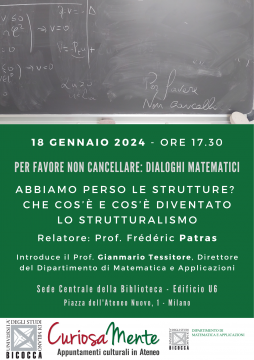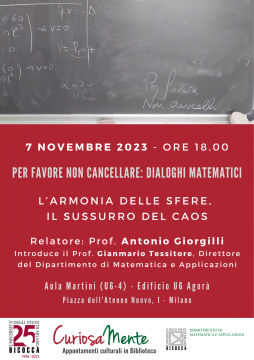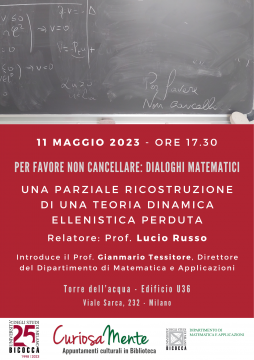Crossings
The "Crossing" initiative is aimed at welcoming some of the protagonists figures in international mathematics to the University of Milano-Bicocca. Every invited researcher will hold two seminars during his/her visit: one focused on a specific topic and the second designed in a wider view. The main aim is to foster scientific collaborations, promote interaction between youth and advanced research, and disseminate the latest and most innovative ideas.
Future Meetings
In progress
Past Meetings
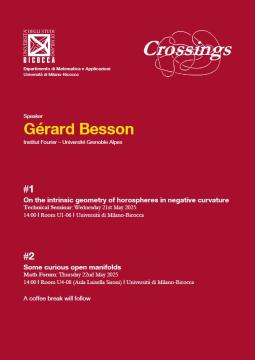
Gérard Besson: Institute Fourier - Université Grenoble Alpes
On 21 and 22 May 2025, the following meetings were held at the University of Milano-Bicocca buildings:
#1
Title: On the intrinsic geometry of horospheres in negative curvature
Abstract: There are classical results showing that if a negatively closed manifold has its horospheres of constant mean curvature then it is locally symmetric. Here we shall present a rigidity result involving the intrinsic Riemannian structure of these horospheres. More precisely if one of them is flat than the closed manifold is locally real hyperbolic.
#2
Title: Some curious open manifolds
Abstract: We shall describe the construction of an open $3$-manifold called the Whitehead Manifold. The construction uses a knot in $S^3$ and variations on it produce a non countable family of strange objects. Very little is known on the Riemannian geometry and the analysis that they carry and we may mention some questions. They also play an important role in dimension 4. The construction will be presented with easy tools.
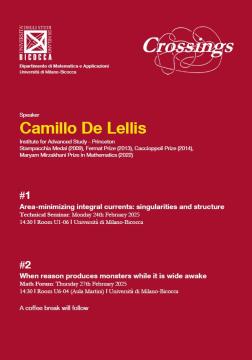
Camillo DE LELLIS: Institute for Advanced Study - Princeton. Stampacchia Medal (2009), Fermat Prize (2013), Caccioppoli Prize (2014), Maryam Mirzakhani Prize in Mathematics (2022).
On 24 and 27 February 2025, the following meetings were held at the University of Milano-Bicocca buildings:
#1
Title: Area-minimizing integral currents: singularities and structure
Abstract: Area-minimizing integral currents were introduced by De Giorgi, Federer, and Fleming to build a successful existence theory for the {\em oriented} Plateau problem. While celebrated examples of singular minimizers were discovered soon after, a first theorem which summarizes the work of several mathematicians in the 60es and 70es (De Giorgi, Fleming, Almgren, Simons, and Federer) and a second theorem of Almgren from 1980 give general dimension bounds for the singular set which match the one of the examples, in codimension 1 and in general codimension respectively.
#2
Title: When reason produces monsters while it is wide awake
Abstract: I turn with terror and horror from this lamentable scourge”. This sentence was uttered by a very famous mathematician towards the end of the XIX century, while referring to the work of another very famous colleague. The object which generated such virulent reaction is actually nowadays rather well accepted, in fact it is often mentioned in basic textbooks on differential calculus. In this lecture I will argue that it is just the first of a long series of counterintuitive mathematical constructions, which all share some common aspects. I will touch upon famous examples of the fifties, sixties, eighties and nineties of the last century, all looking like bizarre games of mathematicians made to defy common sense. However I will finally turn to some discoveries of the last few years, which confirm an old hypothesis of a theoretical physicist, recipient of the Nobel prize in chemistry!
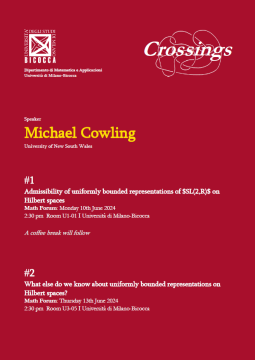
Michael COWLING: University of New South Wales
On 10 and 13 June 2024, the following meetings were held at the University of Milano-Bicocca buildings:
#1
Title: Admissibility of uniformly bounded representations of $SL(2,R)$ on Hilbert spaces
#2
Title: What else do we know about uniformly bounded representations on Hilbert spaces?
Abstract: These presentations are based on work in collaboration with Francesca Astengo (Genova) and Bianca di Blasio (Milano Bicocca). This work will be integrated into its historical and mathematical context. From about 1950, there has been considerable study of the representations $\pi$ of the group $G := SL(2,R)$, andmore generally those of semisimple Lie groups, on Hilbert spaces $\cH$. Some of these representations areisometric, that is, $\| \pi(g)\xi \| = \| \xi \|$ for all $g \in G$ and $\xi \in \cH$. Others are uniformly bounded, that is, theoperator norms of the $\pi(g)$ are uniformly bounded in $G$. An early question (1950) of Dixmier was whether every uniformly bounded representation of a locally compact groupis similar to a unitary representation; a counterexample was found by Ehrenpreis and Mautner in 1955. During thissame period, Harish-Chandra introduced the concept of admissible representation (which means essentiallyaccessible with the tools of algebra) and showed that irreducible unitary representations are admissible. In 1988 Soergel constructed an example of a nonadmissible isometric representation of $G$ on a Banach space, using thenegative solution of the so-called invariant subspace problem in Banach spaces (due to Enflo and Read). Recentlytwo proposed solutions of the same problem in Hilbert spaces (by Enflo and by Neville have appeared; these bothclaim that the invariant subspace problem has a positive solution.
In the first talk, we show that if the proposed solutions to the invariant subspace problem in Hilbert spaces are valid, then uniformly bounded representations of $SL(2,R)$ are admissible.
In the second, we ask what uniformly bounded representations are good for. We present a summary of known resultsabout them and mention a few of their applications (one of which is still conjectural).
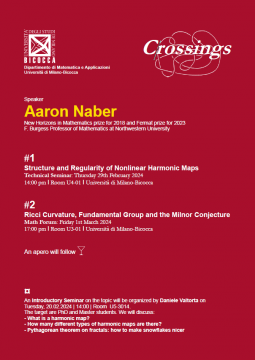
Aaron Naber: New Horizons in Mathematics prize for 2018 and Fermat prize for 2023 F. Burgess Professor of Mathematics at Northwestern University.
On 29 February and 1st March 2024, the following meetings were held at the University of Milano-Bicocca buildings:
#1
Title: Structure and Regularity of Nonlinear Harmonic Maps
Abstract: We will consider harmonic maps between Riemannian manifolds u:M->N . The first part of the talk will discuss and explain the known regularity of such mappings, in particular joint work with Daniele Valtorta on the size and rectifiability of the singular sets. The second part of the talk will focus on sequences of such mappings u_j:M->N, where it is known that blow-up can occur on a m-2 dimensional subset. This blow-up is characterized by the so-called defect measure, which we will review and discuss. In recent joint work with Valtorta we have proved the energy identity, a conjectured explicit description of the defect measure in terms of bubble energy counting.
#2
Title: Ricci Curvature, Fundamental Group and the Milnor Conjecture
Abstract: Crossings between geometry, algebra and analysis. In 1968 Milnor conjectured that there is a powerful link between Ricci curvature and the fundamental group of a manifold. After 50 years, we discuss a counterexample, because math never stops being surprising. In particular, it was conjectured by Milnor in 1968 that the fundamental group of a complete manifold with nonnegative Ricci curvature is finitely generated. In this talk, we will discuss a counterexample, which provides an example M^7 with Ric>= 0 such that \pi_1(M)=Q/Z is infinitely generated. The work is joint with Elia Brue and Daniele Semola. There are several new points behind the result. The first is a new topological construction for building manifolds with infinitely generated fundamental groups, which can be interpreted as a smooth version of the fractal snowflake. The ability to build such a fractal structure will rely on a very twisted glueing mechanism. Thus the other new point is a careful analysis of the mapping class group \pi_0Diff(S^3\times S^3) and its relationship to Ricci curvature. In particular, a key point will be to show that the action of \pi_0Diff(S^3\times S^3) on the standard metric g_{S^3\times S^3} lives in a path connected component of the space of metrics with Ric>0.
